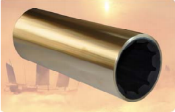o ring hydraulic seals
Understanding O-Ring Hydraulic Seals
O-ring hydraulic seals are essential components used in various machinery and equipment to prevent fluid leakage. These seals play a crucial role in the functionality of hydraulic systems, ensuring that pressure is maintained and that the system operates efficiently. This article delves into the characteristics, applications, advantages, and maintenance of O-ring hydraulic seals.
What is an O-Ring?
An O-ring is a circular rubber seal that is typically made from elastomers. The shape resembles the letter O, and it acts as a barrier to keep fluids contained within hydraulic systems. When compressed between two components, O-rings create a seal that prevents the escape of hydraulic fluid, making them critical for the performance and reliability of hydraulic machinery.
Characteristics of O-Ring Hydraulic Seals
O-rings come in various sizes and materials, tailored specifically for different applications. Common materials include nitrile, fluorocarbon, and silicone, each offering unique properties such as temperature resistance, chemical compatibility, and durability. The choice of material affects the seal's effectiveness in specific environments, especially where high pressures or extreme temperatures are involved.
The design of O-rings allows for easy installation and replacement, making them user-friendly. They are versatile, suitable for both dynamic (moving) and static (stationary) applications. However, the effectiveness of O-rings depends on their proper sizing, material selection, and installation techniques.
Applications of O-Ring Hydraulic Seals
O-ring hydraulic seals are widely used across various industries. In automotive applications, they are found in brake systems, transmission systems, and power steering mechanisms. In the aerospace industry, O-rings are utilized in hydraulic systems and fuel systems, providing reliable sealing under extreme conditions. They are also vital in industrial machinery, hydraulic pumps, and cylinders, ensuring optimal performance while preventing fluid leakage.
o ring hydraulic seals

Their versatility extends to household appliances, such as dishwashers and washing machines, where they contribute to the overall efficiency and functionality. The medical industry also relies on O-rings for sealing applications in medical devices, ensuring safety and reliability.
Advantages of O-Ring Hydraulic Seals
One of the key advantages of using O-ring hydraulic seals is their effectiveness in preventing fluid leakage. This not only enhances the efficiency of hydraulic systems but also minimizes the risk of environmental contamination caused by leaks. O-rings are also cost-effective, providing a reliable sealing solution without the need for complex installation processes.
Additionally, O-rings can accommodate a wide range of operating conditions, including variations in temperature and pressure. Their resilience and adaptability make them a preferred choice for many applications. Furthermore, regular inspection and maintenance can easily address any wear and tear, prolonging their lifespan.
Maintenance and Best Practices
To ensure the longevity and proper functionality of O-ring hydraulic seals, regular maintenance is essential. Inspecting O-rings for signs of wear, such as cracks or deformation, can prevent failures that may lead to costly repairs and downtime. Choosing the right lubricant compatible with the seal material can also enhance performance and reduce friction.
Ideal installation practices, such as ensuring clean mating surfaces and avoiding over-tightening, are crucial. Properly sized and selected O-rings can significantly reduce the chances of leakage and enhance overall system performance.
Conclusion
O-ring hydraulic seals serve as a cornerstone in the functionality of hydraulic systems across various industries. Their unique characteristics, wide applicability, and ease of maintenance make them indispensable components. By understanding their role and implementing best practices, users can harness the full potential of these vital seals in their operations.
-
Simplifying Oil Changes: A Comprehensive Guide to Oil Drain Plugs and Their Variants
News Aug.04,2025
-
Mastering Oil Drain Maintenance: Solutions for Stripped, Worn, and Upgraded Oil Plugs
News Aug.04,2025
-
Fixing Oil Pan Plug Issues: Leaks, Stripped Nuts, and the Right Replacement Solutions
News Aug.04,2025
-
Everything You Need to Know About Oil Drain Plugs: Sizes, Fixes, and Upgrades
News Aug.04,2025
-
Choosing the Right Oil Drain Plug: A Guide to Sizes, Materials, and Drain Innovations
News Aug.04,2025
-
A Complete Guide to Automotive Drain Plugs: Types, Problems, and Innovative Solutions
News Aug.04,2025
-
The Ultimate Guide to Car Repair Kits: Tools and Essentials Every Driver Should Own
News Aug.01,2025
Products categories















